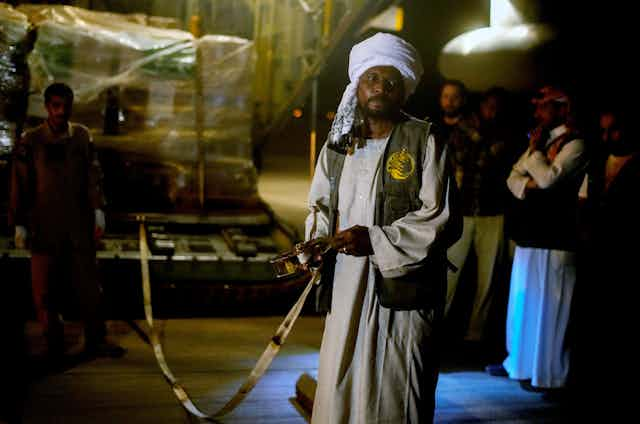Reports out of Sudan of continuing violence suggest that the seven-day ceasefire organised during talks in Jeddah – the seventh attempt to end the violence in Sudan – is crumbling. A fighter plane was shot down over Khartoum on May 24 and residents report intense fighting breaking out once again in some areas.
The talks, sponsored by Saudi Arabia and the US, are understood to have had a narrow focus based on bringing humanitarian assistance to the Sudanese people, according to US secretary of state, Antony Blinken.
Blinken’s threat of repercussions “through sanctions and other means” on truce breakers initially led to optimism aid corridors and escape routes could be provided for civilians trapped in the belly of the conflict. But clashes continue and people remain trapped without basic supplies and medicine.
This casts doubt on ramping up an already slow humanitarian response amid soaring needs. The UN reports that more than half of the population – about 25 million people – now need humanitarian assistance. Food, water, health and hygiene support are the main needs following the destruction of essential infrastructure, with markets and energy supply taking a hit.
Much of the aid to have arrived in Sudan is understood to be held up in the eastern coastal city of Port Sudan while aid agencies wait for security permits.
One of the main themes of my doctoral research was the successful provision of humanitarian aid in armed conflicts. Of the various issues I found to play a role, three stand out in the context of Sudan.
Confused chain of command
The first is the number of warring parties and the uncertain chain of command. The fewer parties there are, the tighter the chain of command tends to be and the easier it is for humanitarian organisations to obtain reliable security guarantees from all sides.
As has been widely reported, the violence in Sudan has mainly been due to a falling out between the Sudanese Armed Forces and the paramilitary Rapid Support Forces and their leaders. But there are also a host of other armed groups operating in various parts of the country.
This makes for a weak and uncertain chain of command. Any security guarantees received by humanitarian organisations from just one group may turn out to be worthless.
The The International Committee of the Red Cross and Doctors without Borders are calling for all armed parties to ensure that supplies and personnel reach places where they are most needed reveal the scale of the problem. But achieving this will be a delicate operation.
Guns, sticks and stones
The second issue relates to the sophistication of weapons used. In Sudan, these range from army-controlled warplanes carrying out airstrikes in the streets of Khartoum to the the armoured jeeps carrying small arms so familiar in similar civil wars.
More sophisticated weaponry can make for more devastating attacks, but they are also usually subject to a command and control system – as seen in the war in Ukraine.
So the terrible irony of the lack of sophisticated weaponry is that it makes the violence harder to control, leading to frequent disruptions and difficult access for international humanitarian organisations. They face high-impact violence and more frequent smaller-scale attacks, which make it all the more difficult to find safe windows of access for aid workers.
Flouting humanitarian law
The matter is made all the worse if any of the parties to the violence cannot be trusted to respect international humanitarian law. The UN envoy in Sudan, Volker Perthes, told Sky News that the agency had lost vehicles and more than 4,000 metric tonnes of humanitarian supplies through looting of warehouses and food trucks. Staff were held at gunpoint and there was a sexual assault attempt on a female member of staff.
The UN’s World Food Programme was forced to suspend its activities after three members of staff were killed on the day fighting broke out in April. Doctors Without Borders has reported repeated attacks on its personnel and facilities.
Such events force humanitarian organisations to retreat and avoid keeping supplies close to where they are needed. This leads to populations in need being cut off from receiving lifesaving assistance.
Facing the humanitarian challenge
The situation in Sudan is more challenging than in most recent conflicts because of these factors. The plethora of armed groups involved in the violence means that security and access have been almost impossible to negotiate so far. Even Sudan’s Central Reserve Police are in reality also involved in the violence.
Whether any truce between the army and RSF will hold depends on the effectiveness of monitoring and enforcement mechanisms adopted by the agreement’s sponsors. And other armed groups must be formally held to the same expectations. The consequences for failing to respect international humanitarian law should apply to all armed groups, who must also be included in negotiations.
Technological solutions such as telemedicine and the use of drones and airdrops to deliver supplies, might help alleviate the challenges. If a truce can be made to holds (and this is a big if), it might also mean that the parties to the conflict will avoid shooting down aircraft or drones carrying supplies.
The scale of the crisis, the costs of deploying such technologies (donors must be willing to fund this), and the unresolved ethical concerns surrounding their use, means this is an ambitious and complex plan. But the use of remote support to provide aid to civilians in warring Syria gives some hope.
Meanwhile, no effort should be spared to finding and refining other solutions to improving access in Sudan. Otherwise, ordinary people will continue to suffer – and time is running out.

